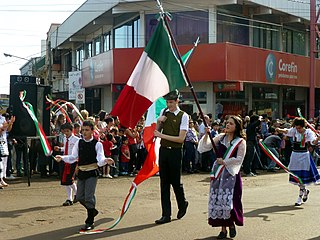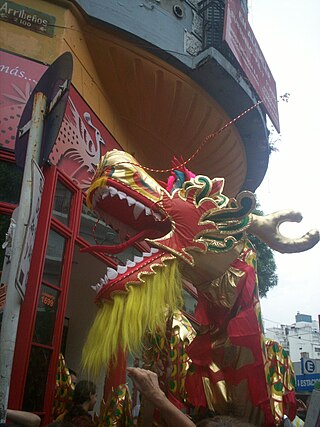
Immigration to Argentina began in several millennia BCE with the arrival of different populations from Asia to the Americas through Beringia, according to the most accepted theories, and were slowly populating the Americas. Upon arrival of the Spaniards, the native inhabitants of Argentine territory were approximately 300,000 people belonging to many Indigenous American civilizations, cultures, and tribes.
Irish Argentines are Argentine citizens who are fully or partially of Irish descent. Irish emigrants from the Midlands, Wexford and many counties of Ireland arrived in Argentina mainly from 1830 to 1930, with the largest wave taking place in 1850–1870. The modern Irish-Argentine community is composed of some of their descendants, and the total number is estimated at between 500,000 and 1,000,000.
English Argentines are citizens of Argentina or the children of Argentine citizens brought up in Argentina, who can claim ancestry originating in England. The English settlement in Argentina, took place in the period after Argentina's independence from Spain through the 19th century. Unlike many other waves of immigration to Argentina, English immigrants were not usually leaving England because of poverty or persecution, but went to Argentina as industrialists and major landowners.

Basque Argentines are Argentine citizens of Basque descent or people from Basque residing in Argentina. Basque Argentines are one of the largest Basque diaspora groups in the world.

The history of the Jews in Argentina goes back to the early sixteenth century, following the Jewish expulsion from Spain. Sephardi Jews fleeing persecution immigrated with explorers and colonists to settle in what is now Argentina, in spite of being forbidden from travelling to the American colonies. In addition, many of the Portuguese traders in the Viceroyalty of the Río de la Plata were Jewish. An organized Jewish community, however, did not develop until after Argentina gained independence from Spain in 1816. By mid-century, Jews from France and other parts of Western Europe, fleeing the social and economic disruptions of revolutions, began to settle in Argentina.

Armenian Argentines are ethnic Armenians who live in Argentina. Estimates vary, but between 70,000 and 120,000 people of Armenian ancestry live in the country, forming one of the largest groups in the Armenian diaspora worldwide. The core of the population came from Cilicia, Syria and Lebanon.

German Argentines are Argentines of German ancestry as well as German citizens living in Argentina. They are descendants of Germans who immigrated to Argentina from Germany and elsewhere in Europe. Some German Argentines originally settled in Brazil, then later immigrated to Argentina. Although Germany as a political entity was founded in 1871, the German language and culture have traditionally been more important than the country of origin, as the basis of the ethnic and national consciousness of Germans. Today, German Argentines make up the fifth-largest ethnic group in Argentina, with over two million citizens of Volga German descent alone.
Argentine Americans are Americans whose full or partial origin hails from Argentina.

Greek Argentines are Argentine citizens of Greek descent or Greek-born people who reside in Argentina. Despite not being as large as other Europe communities, the Greeks have contributed a lot to their new country. The first immigrants arrived at the end of the 18th century, while the bulk of immigration occurred during the first half of the 20th century.

Italian Argentines are Argentine-born citizens who are fully or partially of Italian descent, whose ancestors were Italians who emigrated to Argentina during the Italian diaspora, or Italian-born people in Argentina.

Scottish Argentines are Argentine citizens of Scottish descent or Scottish-born people who reside in Argentina. A Scottish Argentine population has existed since at least 1825. Frequently, Scottish Argentines are wrongly referred to as English. Scottish Argentines celebrate Scottish culture and hold parades for Scottish celebrations, like Burns Night.

French Argentines refers to Argentine citizens of full or partial French ancestry or persons born in France who reside in Argentina. French Argentines form one of the largest ancestry groups after Italian Argentines and Spanish Argentines. Between 1857 and 1946, 261,020 French people immigrated to Argentina. Besides immigration from continental France, Argentina also received, as early as the 1840s, immigrants with French background from neighboring countries, notably Uruguay, which expanded the French Argentine community., it was estimated that around 7 million Argentines had some degree of French ancestry, up to 17% of the total population.
Russian Argentines are people from Russia living in Argentina, and their Argentine-born descendants. The estimates of the number of Argentines of Russian descent vary between 170,000 and 350,000. They are mostly living in Buenos Aires and Greater Buenos Aires.

European Argentines or White Argentines belong to several communities which trace their origins to various migrations from Europe and which have contributed to the country's cultural and demographic variety. They are the descendants of colonists from Spain during the colonial period prior to 1810, or in the majority of cases, of Spanish, Italians, French, Russians and other Europeans who arrived in the great immigration wave from the mid 19th to the mid 20th centuries, and who largely intermarried among their many nationalities during and after this wave. No recent Argentine census has included comprehensive questions on ethnicity, although numerous studies have determined that European Argentinians have been a majority in the country since 1914.

Chinese Argentines are Argentine citizens of Chinese ancestry or Chinese-born immigrants. The Chinese Argentine community is one of the fastest-growing communities in Argentina. As of 2018, the community was made up of 200,000 people.
Japanese Argentines or Japanese Argentinians, are Argentine citizens of Japanese ancestry, comprising Japanese immigrants and their descendants born in Argentina. Japanese migration to Argentina began in 1908 with the arrival of immigrants from Okinawa and Kagoshima. The first Japanese entered the country via Brazil and succeeding groups of immigrants tended to reach Argentina through the neighboring nations. In the pre-war years, Japanese Argentines were concentrated in urban small businesses, especially dry cleaning and cafes in Buenos Aires, while some worked as domestic servants, factory workers and longshoremen. A minority of Japanese Argentines also engaged in horticulture, floriculture and fishery. There is an important Japanese community in the city of Belén de Escobar where they settled and specialised in floriculture.

There is a significant Argentine diaspora in Mexico. According to the 2010 census, there were 13,696 registered Argentine citizens living in Mexico, an increase from the 6,465 registered in the 2000 census. Argentine immigrants constitute the second largest community of South Americans in Mexico and the fifth largest immigrant community overall.
Syrian Argentines are Argentine citizens of Syrian descent or Syrian-born people who reside in Argentina. Argentina has the second highest number of Syrians in South America after Brazil. Syrian immigration to Argentina has been and is currently, one of the most important Arab migration flows into Argentina. Immigration waves peaked in the 20th century, although in recent years due to the constant wars in the Middle East, immigration from Syria has been increasing over time. Like other Arab Argentines, they are universally known as "turcos" ("Turks"), like in the rest of Latin American countries.
Argentine Jews in Israel are immigrants and descendants of the immigrants of the Argentine Jewish community who now reside within the state of Israel. Argentine Jewish immigration to Israel has been, and still is, the largest and most significant migratory flow from South America. This is because Argentina has one of the largest Jewish communities in the world, the third largest in the Americas after those in the United States and Canada, and seventh worldwide. Because of this, many Jewish Argentines are able to make aliyah and become Israeli citizens through the Law of Return. The Argentine community in Israel is about 50,000 people, although some estimates put the figure at 70,000, making it one of the fastest-growing groups in the country.

Argentine Venezuelans are Venezuelan citizens of partial or full Argentine descent, or Argentine citizens who have migrated to and settled in Venezuela. Many Argentines fled their country and settled in Venezuela during the military dictatorship that ruled Argentina from 1976 to 1983. In 2019, an estimate numbered Argentine Venezuelans still living in Venezuela at 9,740.













